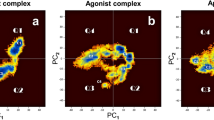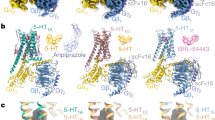Abstract
A three-dimensional molecular model of the transmembrane domain of the 5-HT1A receptor (5-HT1AR) is presented in the context of a general strategy for modeling the macromolecular structure of a guanine nucleotide binding, regulatory protein coupled receptor (GPCR). The model of the 5-HT1AR rests on the definition of the putative residues of the ligand-binding site guided by criteria based on specific models proposed from structure-activity studies and on published results of modifications of GPCRs using methods of molecular biology. The resulting requirements for matching recognition sites in the agonist-binding pocket define the molecular details of the interaction between the agonist 5-HT and the human 5-HT1AR that includes: (1) the interaction between the protonated amine moiety and the conserved negative Asp-116, located in TMH 3; (2) the hydrogen bond between the hydroxyl group and Thr-199, located in TMH 5; and (3) the interaction complex between the aromatic ring portion of the ligand and the neutral form of His-192, located in TMH 5. Results from quantum mechanical calculations of the interaction between an agonist and the proposed recognition pocket of the 5-HT1AR model suggest a trigger of the receptor activation mechanism resulting from ligand binding. The antagonist-binding pocket of the human 5-HT1AR is inferred from the interaction sites of pindolol with the receptor model: (1) the ionic interaction between the protonated amine of the ligand and the side chain of the conserved Asp-116, located in TMH 3; and (2) the hydrogen bonds between the ether oxygen and the hydroxyl group of the ligand and Asn-385, located in TMH 7. Use of the model is proposed to facilitate the identification of the structural elements of agonists and antagonists that are key for their specific functions, in order to achieve the design of new compounds with predetermined pharmacological properties.
Similar content being viewed by others
References
Albert PR, Zhou Q, Van Tol HHM, Bunzow JR, Civelli O. Cloning, functional expression, and mRNA tissue distribution of the rat 5-hydroxytryptamine1a receptor gene. J Biol Chem 265:5825–5832;1990.
Arvidsson L-E, Karlen A, Norinder U, Kenne L, Sundell S, Hacksell U. Structural factors of importance for 5-hydroxytryptaminergic activity: Conformational preferences and electrostatic potentials of 8-hydroxy-2-(di-n-propylamino)tetralin(8-OH-DPAT) and some related agents. J Med Chem 31:212–221;1988.
Baldwin JM. The probable arrangement of the helices in G protein-coupled receptors. EMBO J 12:1693–1703;1993.
Baldwin JM. Structure and function of receptors coupled to G proteins. Curr Opin Cell Biol 6:180–190;1994.
Ballesteros JA, Weinstein H. Integrated methods for the construction of three-dimensional models and computational probing of structure-function relations in G-protein-coupled receptors. Methods Neurosci 25:366–428;1995.
Brooks BR, Bruccoleri RE, Olafson BD, States DJ, Swaminathan S, Karplus M. CHARMM: A program for macromolecular energy, minimization, and dynamics calculations. J Comput Chem 4:187–217;1983.
Burley SK, Petsko GA. Weakly polar interactions in proteins. Adv Protein Chem 39:125–188;1988.
Chanda PK, Minchin MC, Davis AR, Greenberg L, Reilly Y, McGregor WH, Bhat R, Lubeck MD, Mizutani S, Hung PP. Identification of residues important for ligand binding to the human 5-hydroxytryptamine1A serotonin receptor. Mol Pharmacol 43:516–520;1993.
Cornfield LJ, Lambert G, Arvidsson L, Mellin C, Vallgårda J, Hacksell U, Nelson DL. Intrinsic activity of enantiomers of 8-hydroxy-2-(di-n-propylamino)tetralin and its analogs at 5-hydroxytryptamine1A receptors that are negatively coupled to adenylate cyclase. Mol Pharmacol 39:780–787;1991.
Dewar MJS, Zoebish EG, Healy EF, Stewart JJP. AM1: A new general purpose quantum mechanical molecular model. J Am Chem Soc 107:3902–3909;1985.
Dixon RAF, Sigal IS, Candelore MR, Register RB, Scattergood W, Rands E, Strader CD. Structural features required for ligand binding to the β-adrenergic receptor. EMBO J 6:3269–3275;1987.
Dohlman HG, Caron MG, DeBlasi A, Frielle T, Lefkowitz RJ. Role of extracellular disulfide-bonded cysteines in the ligand-binding function of the β2-adrenergic receptor. Biochemistry 29:2335–2342;1990.
Dohlman HG, Thorner J, Caron MG, Lefkowitz RJ. Model systems for the study of seven-transmembrane-segment receptors. Annu Rev Biochem 60:653–688;1991.
Fargin A, Raymond JR, Lohse MJ, Kobilka BK, Caron MG, Lefkowitz RJ. The genomic clone G-21 which resembles a β-adrenergic receptor sequence encodes the 5-HT1a receptor. Nature 335:358–360;1988.
Findlay J, Eliopoulos E. Three-dimensional modeling of G protein-linked receptors. Trends Pharmacol Sci 11:492–499;1990.
Fletcher A, Cliffe IA, Dourish CT. Silent 5-HT1A receptor antagonists: Utility as research tools and therapeutic agents. Trends Pharmacol Sci 14:441–448;1993.
Fong TM, Cascieri MA, Yu H, Bansal A, Swain C, Strader CD. Amino-aromatic interaction between histidine 197 of the neurokinin-1 receptor and CP 96345. Nature 362:350–353;1993.
Frisch MJ, Head-Gordon M, Trucks GW, Foresman JB, Schlegel HB, Raghavachari K, Robb MA, Binkley JS, Gonzalez C, Defrees DJ, Fox DJ, Whiteside RA, Seeger R, Melius CF, Baker J, Martin RL, Kahn LR, Stewart JJP, Topiol S, Pople JA, Gaussian 90. Pittsburgh, Gaussian, Inc., 1990.
Glennon RA, Westkaemper RB, Bartyzel P. Medicinal chemistry of serotonergic agents. In: Peroutka SJ, ed. Serotonin Receptor Subtypes: Basic and Clinical Aspects. New York, Wiley-Liss, 19–64;1991.
Guan X, Peroutka SJ, Kobilka BK. Identification of a single amino acid residue responsible for the binding of a class of β-adrenergic receptor antagonists to 5-hydroxytryptamine1A receptors. Mol Pharmacol 41:695–698;1992.
Henderson R, Baldwin JM, Ceska TA, Zemlin F, Beckmann E, Downing KH. Model for the structure of bacteriorhodopsin based on high-resolution electron cryo-microscopy. J Mol Biol 213:899–929;1990.
Ho BY, Karschin A, Branchek T, Davidson N, Lester HA. The role of conserved aspartate and serine residues in ligand binding and in function of the 5-HT1a receptor: A site-directed mutation study. FEBS Lett 312:259–262;1992.
Jäckle H, Luisi PL. Conformational study of histidine- and tryptophan-containing peptides in solution based upon the combination of nuclear magnetic resonance, circular dichroism, and fluorescence measurements. J Phys Chem 88:1767–1777;1984.
Kobilka BK, Frielle T, Collins S, Yang-Feng T, Kobilka TS, Francke U, Lefkowitz RJ, Caron MG. An intronless gene encoding a potential member of the family of receptor coupled to guanine nucleotide regulatory proteins. Nature 329:75–79;1987.
Kurtenbach E, Curtis CAM, Pedder EK, Aitken A, Harris ACM, Hulme EC. Muscarinic acetylcholine receptors. Peptide sequencing identifies residues involved in antagonist binding and disulfide bond formation. J Biol Chem 265:13702–13708;1990.
Makriyannis A, DiMeglio CM, DeJong AP, ElKhateeb S. Hallucinogenic receptor models: Interaction of imidazolium chloride with amphetamine analogs. Mol Pharmacol 43:78–83;1992.
MaloneyHuss K, Lybrand TP. Three-dimensional structure for the β2 adrenergic receptor protein based on computer modeling studies. J Mol Biol 225:859–871;1992.
Maroteaux L, Saudou F, Amlaiky N, Boschert U, Plassat JL, Hen R. Mouse 5HT1B serotonin receptor: Cloning, functional expression, and localization in motor control centers. Proc Natl Acad Sci USA 89:3020–3024;1992.
Mellin C, Vallgårda J, Nelson DL, Björk L, Yu H, Andén N, Csöregh I, Arvidsson L, Hacksell U. A 3-D model for 5-HT-receptor agonists based on stereoselective methyl-substituted and conformationally restricted analogues of 8-hydroxy-2-(dipropylamino)tetralin. J Med Chem 34:497–510;1991.
Mercier GA, Osman R, Weinstein H. Role of primary and secondary protein structures in neurotransmitter activation mechanisms. Protein Eng 2:261–270;1988.
Neer EJ. Heterotrimeric G proteins: Organizers of transmembrane signals. Cell 80:249–257;1995.
Osman R, Topiol S, Rubenstein L, Weinstein H. A molecular model for activation of a 5-hydroxytryptamine receptor. Mol Pharmacol 32:699–705;1987.
Pardo L, Ballesteros JA, Osman R, Weinstein H. On the use of the transmembranal domain of bacteriorhodposin as a template for modeling the 3-D structure of G-protein coupled receptors. Proc Natl Acad Sci USA 89:4009–4012;1992.
Pollock NJ, Manelli AM, Hutchins CW, Steffey ME, MacKenzie RG, Frail DE. Serine mutations in transmembrane V of the dopamine D1 receptor affect ligand interactions and receptor activation. J Biol Chem 267:17780–17786;1992.
Reed AE, Weinstock RB, Weinhod F. Natural population analysis. J Chem Phys 83:735–746;1985.
Schertler GFX, Villa C, Henderson R. Projection structure of rhodopsin. Nature 362:770–772;1993.
Schwartz TW. Locating ligand binding sites in 7TM receptors by protein engineering. Curr Opin Biotechnol 5:434–444;1994.
Sealfon SC, Chi L, Ebersole BJ, Rodic V, Zhang D, Ballesteros JA, Weinstein H. Related contribution of specific helix 2 and 7 residues to conformational activation of the serotonin 5-HT2A receptor. J Biol Chem 270:16683–16688;1995.
Singh J, Thornton JM. Atlas of Protein Side-Chain Interactions. Oxford, IRL Press, 1993.
Strader CD, Candelore MR, Hill WS, Sigal IS, Dixon RAF. Identification of two serine residues involved in agonist activation of the β-adrenergic receptor. J Biol Chem 264:13572–13578;1989.
Strader CD, Gaffney T, Sugg EE, Candelore MR, Keys R, Patchett AA, Dixon RAF. Allele-specific activation of genetically engineered receptors. J Biol Chem 266:5–8;1991.
Strader CD, Sigal IS, Candelore MR, Rands MR, Hill WS, Dixon RAF. Conserved aspartic acid residues 79 and 113 of the β-adrenergic receptor have different roles in receptor function. J Biol Chem 263:10267–10271;1988.
Suryanarayana S, Daunt DA, Zastrow MV, Kobilka BK. A point mutation in the seventh hydrophobic domain of the α2-adrenergic receptor increases its affinity for a family of β-receptor antagonists. J Biol Chem 266:15488–15492;1991.
Suryanarayana S, Kobilka BK. Amino acid substitutions at position 312 in the seventh hydrophobic segment of the β2-adrenergic receptor modify ligand-binding specificity. Mol Pharmacol 44:111–114;1993.
Trumpp-Kallmeyer S, Hoflack J, Bruinvels A, Hibert M. Modeling of G-protein-coupled receptors: Applications to dopamine, adrenaline, serotonin, acetylcholine, and mammalian opsin receptors. J Med Chem 35:3448–3462;1992.
Voight MM, Laurie DJ, Seeburg PH, Bacj A. Molecular cloning and characterization of a rat brain cDNA encoding a 5-hydroxytryptamine1B receptor. EMBO J 10:4017–4023;1991.
Wang C, Buck MA, Fraser CM. Site-directed mutagenesis of α2A-adrenergic receptors: Identification of amino acids involved in ligand binding and receptor activation by agonists. Mol Pharmacol 40:168–179;1991.
Wang C, Gallaher TK, Shih JC. Site-directed mutagenesis of the serotonin 5-hydroxytryptamine2 receptor: Identification of amino acids necessary for ligand binding and receptor activation. Mol Pharmacol 43:931–940;1993.
Weinstein H, Osman R. On the structural and mechanistic basis of function, classification, and ligand design for 5-HT receptors. Neuro-psychopharmacology 3:397–409;1990.
Weinstein H, Osman R, Topiol S, Green JP. Quantum chemical studies on molecular determinants of drug action. Ann NY Acad Sci 367:434–451;1981.
Zhang D, Weinstein H. Signal transduction by a 5-HT2 receptor: A mechanistic hypothesis from molecular dynamics simulations of the three-dimensional model of the receptor complexed to ligands. J Med Chem 36:934–938;1993.
Zhou W, Flanagan C, Ballesteros JA, Konvicka K, Davidson JS, Weinstein H, Millar RP, Sealfon SC. A reciprocal mutation supports helix 2 and helix 7 proximity in the gonadotropin-releasing hormone receptor. Mol Pharmacol 45:165–170;1994.
Author information
Authors and Affiliations
Rights and permissions
About this article
Cite this article
Pardo, L., Batlle, M., Duñach, M. et al. Structure and activity of membrane receptors: Modeling and computational simulation of ligand recognition in a three-dimensional model of the 5-hydroxytryptamine1A receptor. J Biomed Sci 3, 98–107 (1996). https://doi.org/10.1007/BF02255537
Received:
Accepted:
Issue Date:
DOI: https://doi.org/10.1007/BF02255537




